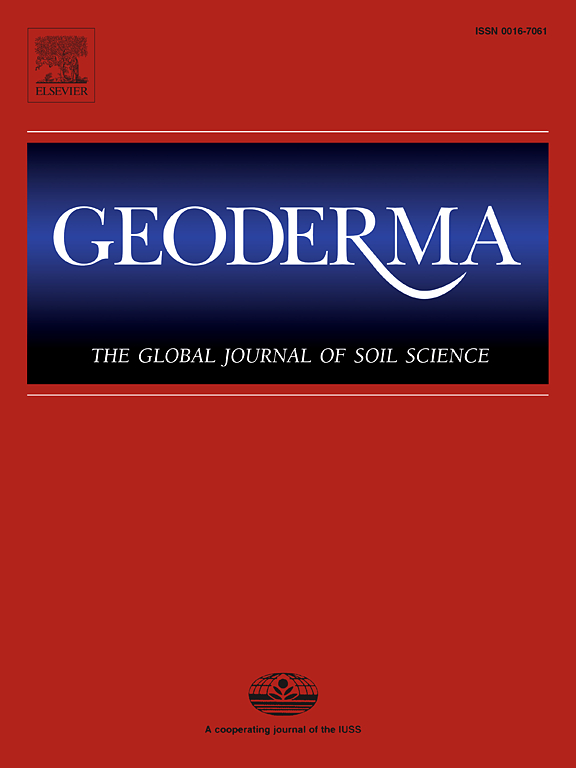Investigating the influence of soil organic carbon on pore structure within aggregates
IF 6.6
1区 农林科学
Q1 SOIL SCIENCE
引用次数: 0
Abstract
Soil pore structural properties, such as porosity, size distribution and geometry, are crucial for various soil processes and are significantly influenced by soil organic carbon (SOC). SOC plays a vital role in determining soil functionality and ecosystem services and is the primary driver of pore geometry within soil aggregates, yet traditional in-situ analysis methods have fallen short in accurately describing its intricate distribution. This study employed a two-stage approach to analyze soil structure at the pore scale: a hydrogen peroxide fogging system was used to selectively remove organic carbon from soil aggregates, followed by synchrotron radiation micro-computed tomography (SR-μCT) for in-depth three-dimensional imaging. The results revealed that the hydrogen peroxide treatment variably reduced organic carbon in soil aggregates, with Cambisol samples showing a higher removal efficiency (38.58–63.31%) compared to Ultisol samples (27.33–45.74%). Mineral-associated organic carbon (MAOC) was more stable than particle organic carbon (POC). SOC depletion led to consistent changes in pore volume across soil types, but the changes in pore shape distribution varied between Cambisols and Ultisols. In Cambisols, SOC removal was associated with more pronounced shifts in pore morphology, whereas Ultisols showed more heterogeneous responses, likely due to differing mineralogical properties. These findings suggest that SOC contributes differently to pore structure depending on soil type. This study aimed to move beyond the traditional “black box” view of soil by visualizing the complex interactions between soil organic carbon (SOC) and soil structure with a new method. This approach could provide valuable insights into the mechanisms behind soil aggregate formation.
研究土壤有机碳对团聚体孔隙结构的影响
土壤孔隙度、大小分布和几何形状等孔隙结构特性对土壤的各种过程至关重要,并受到土壤有机碳(SOC)的显著影响。有机碳在确定土壤功能和生态系统服务中起着至关重要的作用,是土壤团聚体孔隙几何结构的主要驱动因素,但传统的原位分析方法在准确描述其复杂分布方面存在不足。本研究采用两阶段方法在孔隙尺度上分析土壤结构:过氧化氢雾化系统用于选择性去除土壤团聚体中的有机碳,然后使用同步辐射微计算机断层扫描(SR-μCT)进行深度三维成像。结果表明,双氧水处理对土壤团聚体有机碳的去除效果不同,Cambisol样品的去除率为38.58 ~ 63.31%,Ultisol样品的去除率为27.33 ~ 45.74%。矿物伴生有机碳(MAOC)比颗粒有机碳(POC)更稳定。土壤有机碳耗竭导致不同土壤类型孔隙体积的变化一致,但在cambisol和ultisol中孔隙形状分布的变化存在差异。在cambisol中,有机碳的去除与孔隙形态的明显变化有关,而Ultisols则表现出更不均匀的反应,可能是由于不同的矿物学性质。这些结果表明,土壤有机碳对孔隙结构的影响随土壤类型的不同而不同。本研究旨在通过一种新的方法,将土壤有机碳(SOC)与土壤结构之间复杂的相互作用可视化,从而突破传统的土壤“黑盒子”观。这种方法可以为土壤团聚体形成背后的机制提供有价值的见解。
本文章由计算机程序翻译,如有差异,请以英文原文为准。
求助全文
约1分钟内获得全文
求助全文
来源期刊

Geoderma
农林科学-土壤科学
CiteScore
11.80
自引率
6.60%
发文量
597
审稿时长
58 days
期刊介绍:
Geoderma - the global journal of soil science - welcomes authors, readers and soil research from all parts of the world, encourages worldwide soil studies, and embraces all aspects of soil science and its associated pedagogy. The journal particularly welcomes interdisciplinary work focusing on dynamic soil processes and functions across space and time.
 求助内容:
求助内容: 应助结果提醒方式:
应助结果提醒方式:


